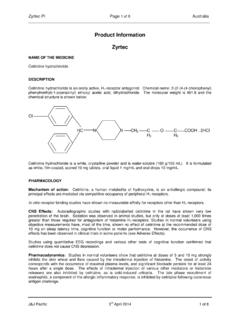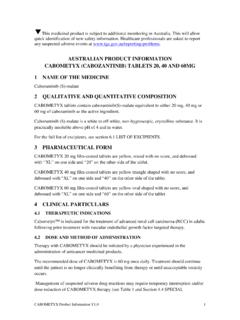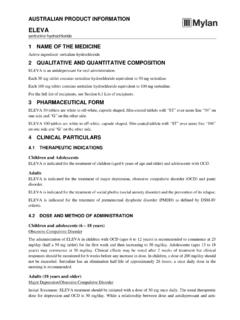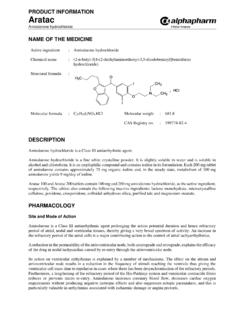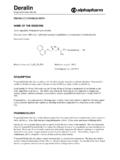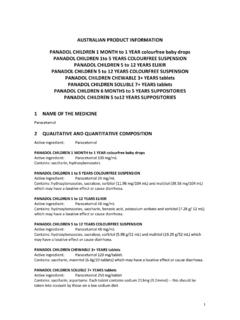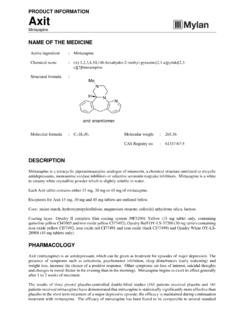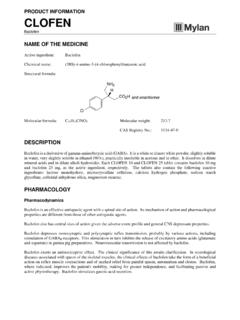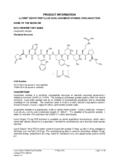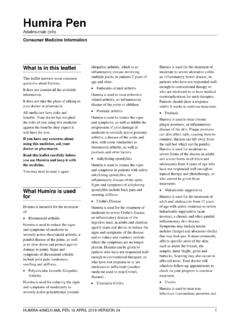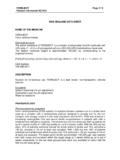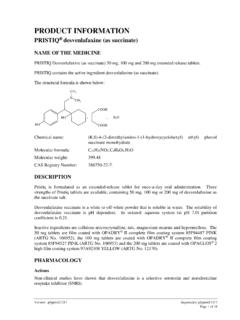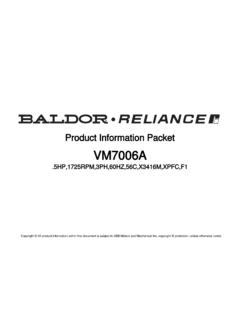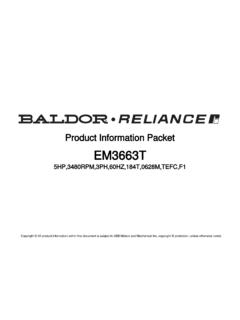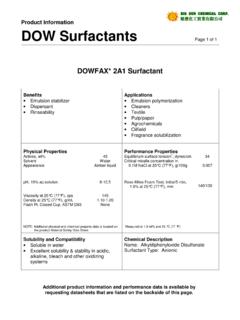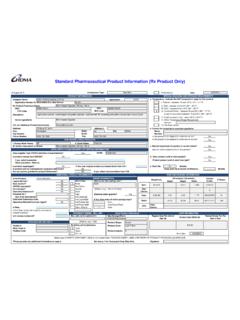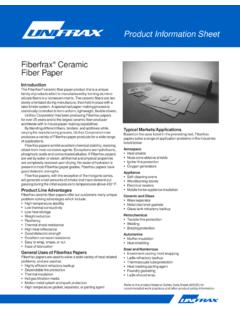Transcription of PRODUCT INFORMATION - Medicines
1 Version: bqpeliqu10118 Supersedes: bqpeliqu11117 Page 1 of 55 PRODUCT INFORMATION ELIQUIS apixaban NAME OF THE MEDICINE Apixaban, a selective inhibitor of the coagulation Factor Xa (FXa), is chemically described as 1-(4-Methoxyphenyl)-7-oxo-6-[4-(2-oxopip eridin-1-yl)phenyl]-4,5,6,7-tetrahydro-1 H-pyrazolo[3,4-c]pyridine-3-carboxamide. Its molecular formula is C25H25N5O4, which corresponds to a molecular weight of Apixaban has the following structural formula: NNNH3 COH2 NOONO CAS Number: 503612-47-3 DESCRIPTION Apixaban is a white to pale yellow powder. At physiological pH ( ), apixaban does not ionize; its aqueous solubility across the physiological pH range is ~ mg/mL. The octanol/water partition coefficient is at pH ELIQUIS film-coated tablets are available for oral administration in strengths of mg and 5 mg apixaban with the following inactive ingredients: lactose, microcrystalline cellulose, croscarmellose sodium, sodium lauryl sulfate, and magnesium stearate.
2 The film coating contains lactose monohydrate, hypromellose, titanium dioxide, glycerol triacetate and yellow iron oxide ( mg tablets) or red iron oxide (5 mg tablets). PHARMACOLOGY Pharmacodynamics The pharmacodynamic effects of apixaban are reflective of the mechanism of action (FXa inhibition). As a result of FXa inhibition, apixaban prolongs clotting tests such as prothrombin time (PT), INR and activated partial thromboplastin time (aPTT). Changes observed in these clotting tests at the expected therapeutic dose are small and subject to a high degree of variability. They are not recommended to assess the pharmacodynamic effects of apixaban. There is no clinical experience with the use of 4-factor PCC products to reverse bleeding in individuals who have received ELIQUIS. Effects of 4-factor PCCs on the Version: bqpeliqu10118 Supersedes: bqpeliqu11117 Page 2 of 55 pharmacodynamics of apixaban were studied in healthy subjects.
3 Following administration of apixaban dosed to steady state, endogenous thrombin potential (ETP) returned to pre-apixaban levels approximately 4 hours after the initiation of a 30 minute PCC infusion, compared to 45 hours with placebo. Mean ETP levels continued to increase and exceeded pre-apixaban levels reaching a maximum (34-51% increase over pre-apixaban levels) at 21 hours after initiating PCC and remained elevated (21 27% increase) at the end of the study (69 hours after initiation of PCC). The clinical relevance of this increase in ETP is unknown. Apixaban also demonstrates anti-FXa activity as evident by reduction in FXa enzyme activity in the Rotachrom Heparin chromogenic assay data from clinical studies. Anti-FXa activity exhibits a close direct linear relationship with apixaban plasma concentration, reaching maximum values at the time of apixaban peak plasma concentrations.
4 The relationship between apixaban plasma concentration and anti-FXa activity is linear over a wide dose range of apixaban. The dose- and concentration-related changes observed following apixaban administration are more pronounced, and less variable, with anti-FXa activity compared with clotting tests. Table 1 below shows the predicted steady state exposure and anti-Factor Xa activity for each indication. In patients taking apixaban for the prevention of VTE following hip or knee replacement surgery, the results demonstrate a less than fluctuation in peak-to-trough levels. In nonvalvular atrial fibrillation patients taking apixaban for the prevention of stroke and systemic embolism, the results demonstrate a less than fluctuation in peak-to-trough levels. In patients taking apixaban for the treatment of VTE or prevention of recurrence of VTE, the results demonstrate a less than fluctuation in peak-to-trough levels.
5 Table 1: Predicted apixaban steady-state exposure (ng/mL) and anti-Xa activity (IU/mL) Apix. Cmax (ng/mL) Apix. Cmin (ng/mL) Apix. Anti-Xa Activity Max (IU/mL) Apix. Anti-Xa Activity Min (IU/mL) Median [5th, 95th Percentile] Prevention of VTE: elective hip or knee replacement surgery mg BID 77 [41, 146] 51 [23, 109] [ , ] [ , ] Prevention of stroke and systemic embolism: NVAF mg BID* 123 [69, 221] 79 [34, 162] [ , ] [ , ] 5 mg BID 171 [91, 321] 103 [41, 230] [ , ] [ , ] Treatment of VTE mg BID 67 [30, 153] 32 [11, 90] [ , ] [ , ] 5 mg BID 132 [59, 302] 63 [22, 177] [ , ] [ , ] 10 mg BID 251 [111, 572] 120 [41, 335] [ , ] [ , ] * Dose adjusted population based on 2 of 3 dose reduction criteria in the ARISTOTLE study. Although treatment with apixaban at the recommended dose does not require routine monitoring of exposure, the use of a calibrated quantitative anti-FXa assay may be useful in exceptional situations where knowledge of apixaban exposure may help to inform clinical decisions, overdose or emergency surgery.
6 Apixaban has no effect on the QTc interval in humans at doses up to 50 mg. Version: bqpeliqu10118 Supersedes: bqpeliqu11117 Page 3 of 55 Mechanism of Action Apixaban is a reversible, direct and highly selective inhibitor of FXa. It does not require antithrombin III for antithrombotic activity. Apixaban inhibits free and clot-bound FXa, and prothrombinase activity. Apixaban has no direct effects on platelet aggregation, but indirectly inhibits platelet aggregation induced by thrombin. By inhibiting FXa, apixaban prevents thrombin generation and thrombus development. Preclinical studies of apixaban in animal models have demonstrated antithrombotic efficacy in the prevention of arterial and venous thrombosis at doses that caused negligible prolongation of prothrombin time and bleeding time in rabbits and dogs, but more than 2-fold increases in prothrombin time and bleeding time in rats.
7 Pharmacokinetics Absorption The absolute bioavailability of apixaban is approximately 50% for doses up to 10 mg. Apixaban is rapidly absorbed with maximum concentrations (Cmax) appearing 3 to 4 hours after tablet intake. Intake with food does not affect apixaban AUC or Cmax at the 10 mg dose. Apixaban can be taken with or without food. Apixaban demonstrates linear pharmacokinetics with dose proportional increases in exposure for oral doses up to 10 mg. At doses 25 mg apixaban displays dissolution limited absorption with decreased bioavailability. Apixaban exposure parameters exhibit low to moderate variability reflected by a within-subject and inter-subject variability of ~ 20% CV and ~ 30% CV, respectively. Following oral administration of 10 mg of apixaban as 2 crushed 5 mg tablets suspended in 30 mL of water, exposure was comparable to exposure after oral administration of 2 intact 5 mg tablets.
8 Following oral administration of 10 mg of apixaban as 2 crushed 5 mg tablets mixed with 30 g of applesauce, Cmax and AUC(inf) and AUC(0-T) were, respectively, , and lower respectively, when compared to administration of 2 intact 5 mg tablets. Following administration of a crushed 5 mg apixaban tablet suspended in 60 mL of 5% dextrose in water (D5W) and delivered via a nasogastric tube, exposure was similar to exposure seen in other clinical trials involving healthy subjects receiving a single oral 5 mg apixaban tablet dose. Distribution Plasma protein binding in humans is approximately 87%. The volume of distribution (Vss) is approximately 21 litres. Metabolism and Elimination Apixaban has multiple routes of elimination. Of the administered apixaban dose in humans, approximately 25% was recovered as metabolites, with the majority recovered in faeces.
9 Renal excretion of apixaban accounts for approximately 27% of total clearance. Additional contributions from biliary and direct intestinal excretion were observed in clinical and nonclinical studies, respectively. Apixaban has a total clearance of about L/h and a half-life of approximately 12 hours. Version: bqpeliqu10118 Supersedes: bqpeliqu11117 Page 4 of 55 O-demethylation and hydroxylation at the 3-oxopiperidinyl moiety are the major sites of biotransformation. Apixaban is metabolised mainly via CYP3A4/5 with minor contributions from CYP1A2, 2C8, 2C9, 2C19, and 2J2. Unchanged apixaban is the major drug-related component in human plasma with no active circulating metabolites present. Apixaban is a substrate of efflux transport proteins, P-glycoprotein (P-gp) and breast cancer resistance protein (BCRP).
10 Special Populations Elderly Elderly patients (above 65 years) exhibited higher plasma concentrations than younger patients, with mean AUC values being approximately 32% higher. No dose adjustment is required, except for atrial fibrillation patients with two of the following criteria; age 80 years, body weight 60 kg, serum creatinine 133 mol/L (see DOSAGE AND ADMINISTRATION, Prevention of Stroke and Systemic Embolism: Non-valvular Atrial Fibrillation, Use in the Elderly, Use in Renal Impairment, Body Weight). Children and Adolescents The efficacy and safety of ELIQUIS in children and adolescents below age 18 have not been established. No data are available. Gender Exposure to apixaban was approximately 18% higher in females than in males. No dose adjustment is required. Race The results across phase I studies showed no discernible difference in apixaban pharmacokinetics between White/Caucasian, Asian and Black/African American subjects.
